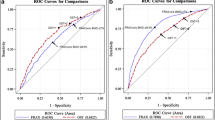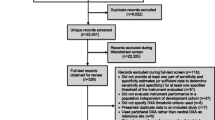Abstract
BACKGROUND: Dual energy x-ray absorptiometry (DXA), coupled with early treatment, may reduce morbidity and mortality associated with osteoporosis. Clinical tools to enhance selection of women for DXA screening have not been developed or validated in an ethnically diverse population.
OBJECTIVE: To compare the performance of the osteoporosis risk assessment instrument (ORAI) and the simple calculated osteoporosis risk estimation (SCORE) instrument across 3 racial/ethnic groups to identify women who would benefit from DXA scans.
DESIGN: Blinded comparison of the instruments in a cross-sectional sample.
PARTICIPANTS: Two-hundred twenty-six postmenopausal women were recruited from a university-based family medicine clinic. Women with a prior diagnosis of osteoporosis or those taking bone active medications were excluded.
MEASUREMENTS: Participants completed a questionnaire that contained the ORAI and the SCORE questions; 203 completed a DXA scan.
RESULTS: The sensitivity and specificity for the ORAI (0.68, [0.49 to 0.88, 95% CI]; 0.66, [0.59 to 0.73, 95% CI]) and the SCORE instrument (0.54, [0.34 to 0.75, 95% CI]; 0.72, [0.65 to 0.78, 95% CI]) differed significantly from previous reports. Overall, the accuracy of the ORAI (66.5%) and SCORE instrument (70.0%) were similar (McNemar’s test P value=37). The accuracy between instruments differed significantly in African-American women (McNemar’s test, P value <.001). In African Americans, the SCORE instrument correctly identified more women without osteoporosis, but missed 70% of those with osteoporosis.
CONCLUSIONS: The performance of the ORAI and SCORE instrument differed significantly from previous reports. Although both can reduce the use of DXA scans for screening for osteoporosis, lower sensitivities resulted in underrecognition of osteoporosis and may limit their clinical usefulness in an ethnically diverse population.
Similar content being viewed by others
References
Ray N, Chan J, Thamer M, Melton M. Medical expenditures for the treatment of osteoporotic fractures in the United States in 1995: report from the National Osteoporosis Foundation. J Bone Miner Res. 1997;12:24–35.
Black D, Cummings S, Karpf D, et al. Randomised trial of effect of alendronate on risk of fracture in women with existing vertebral fractures. Lancet. 1996;347:1535–41.
Black D, Thompson D, Bauer D, et al. Fracture risk reduction with alendronate in women with osteoporosis: the fracture intervention trial. J Clin Endocrinol Metab. 2000;85:4118–24.
Bone H, Greenspan S, McKeever C, et al. Alendronate and estrogen effects in postmenopausal women with low bone mineral density. J Clin Endocrinol Metab. 2000;85:720–6.
Downs RJ, Bell N, Ettinger M, et al. Comparison of alendronate and intranasal calcitonin for treatment of osteoporosis in postmenopausal women. J Clin Endocrinol Metab. 2000;85:1783–8.
Ensrud K, Black D, Palermo L, et al. Treatment with alendronate prevents fractures in women at highest risk: results from the fracture intervention trial. Arch Intern Med. 1997;157:2617–24.
Delmas P. Treatment of postmenopausal osteoporosis. Lancet. 2002;359:2018–26.
Hodsman A, Hanley D, Robert J. Do bisphosphonates reduce the risk of osteoporotic fractures? An evaluation of the evidence to date. Can Med Assoc J. 2002;166:1426–30.
Hosking D, Chilvers C, Christiansen C, et al. Prevention of bone loss with alendronate in postmenopausal women under 60 years of age. N Engl J Med. 1998;338:485–92.
Epstein S. Postmenopausal osteoporosis: fracture consequences and treatment efficacy vary by skeletal site. Aging Clin Exp Res. 2000;12:330–41.
Harris S, Watts N, Genant H, et al. Effects of risedronate treatment on vertebral and nonvertebral fractures in women with postmenopausal osteoporosis: a randomized controlled trial. JAMA. 1999;282:1344–52.
McClung M, Geusens P, Miller P, et al. Effect of risedronate on the risk of hip fracture in elderly women. N Engl J Med. 2001;344:333–40.
U.S. Preventive Services Task Force. Screening for osteoporosis in postmenopausal women: recommendations and rationale. Ann Intern Med. 2002;137:526–8.
National Osteoporosis Foundation. NOF applauds USPSTF recommendations on BMD tests. NOF Press Release, September 16, 2002
Wanko S, Inouye L. Gender and ethnic disparities in osteoporosis risk factors and screening. J Gen Intern Med. 2003;18(Suppl 1):266.
Michaëlsson K, Bergstrom R, Mallmin H, Holmberg L, Wolk A, Ljunghall S. Screening for osteopenia and osteoporosis: selection by body composition. Osteoporos Int. 1996;6:120–6.
Lydick E, Cook K, Turpin J, Melton M, Stine R, Byrnes C. Development and validation of a simple questionnaire to facilitate identification of women likely to have low bone density. Am J Managed Care. 1998;4:37–48.
Black D, Palermo L, Pearson J, Abbott T, Johnell O. SOFSURF: a simple, useful risk factor system can identify the large majority of women with osteoporosis. Bone. 1998;23(Suppl 5):S605.
Weinstein L, Ullery B, Bourguignon C. A simple system to determine who needs osteoporosis screening. Obstet Gynecol. 1999;93(Part 1):757–60.
Cadarette S, Jaglal S, Kreiger N, McIsaac W, Darlington G, Tu J. Development and validation of the osteoporosis risk assessment instrument to facilitate selection of women for bone densitometry. Can Med Assoc J. 2000;162:1289–94.
Koh L, Sedrine W, Torralba T, et al. A simple tool to identify Asian women at increased risk of osteoporosis. Osteoporos Int. 2001;12:699–705.
National Osteoporosis Foundation. Physician’s Guide to Prevention and Treatment of Osteoporosis. Washington, DC: National Osteoporosis Foundation; 2003.
World Health Organization. Assessment of Fracture Risk and its Application to Screening for Postmenopausal Osteoporosis. Geneva: World Health Organization; 1994.
Cadarette S, Jaglal S, Murray T, et al. Evaluation of decision rules for referring women for bone densitometry by dual-energy x-ray absorptiometry. JAMA. 2001;286:57–63.
McNemar Q. Note on the sampling error of the difference between correlated proportions or percentages. Psychometrika. 1947;12:153–7.
Elashoff JD. nQuery Advisor Version 4.0 User’s Guide. Los Angeles, CA: Statistical Solutions Ltd; 2000.
Looker A, Johnston C, Wahner H, et al. Prevalence of low femoral bone density in older US women from NHANES III. J Bone Miner Res. 1995;10:796–802.
Anonymous. Osteoporosis among estrogen-deficient women—United States, 1988–1994. MMWR. 1998;47:969–73.
Looker A, Wahner H, Dunn W, et al. Updated data on proximal femur bone mineral levels of US adults. Osteoporos Int. 1998;8:468–89.
Looker A, Orwoll E, Johnston C, et al. Prevalence of low femoral bone density in older US adults from NHANES III. J Bone Miner Res. 1997;12:1761–8.
Silverman S, Madison R. Decreased incidence of hip fracture in Hispanics, Asians, and Blacks: California hospital discharge data. Am J Public Health. 1988;78:1482–3.
Finkelstein J, Lee M, Sowers M, et al. Ethnic variation in bone density in premenopausal and early perimenopausal women: effects of anthroppometric and lifestyle factors. J Clin Endocrinol Metab. 2002;87:3057–67.
Binstock M. Osteoporosis: risk factor prevalence and drug and densitometry utilization. Obstet Gynecol. 2000;95(Suppl 4):50S.
Author information
Authors and Affiliations
Corresponding author
Additional information
Prior presentations: Clinical Stratification of Risk for Osteoporosis in Women from an Ethnically Diverse Population, October 25 to 28, 2003, Banff, Alberta, Canada, North American Primary Care Research Group Annual Meeting.
Conflict of interest notification: The authors have no potential conflicts of interest to disclose.
Rights and permissions
About this article
Cite this article
Cass, A.R., Shepherd, A.J. & Carlson, C.A. Osteoporosis risk assessment and ethnicity. J Gen Intern Med 21, 630–635 (2006). https://doi.org/10.1111/j.1525-1497.2006.00459.x
Received:
Revised:
Accepted:
Issue Date:
DOI: https://doi.org/10.1111/j.1525-1497.2006.00459.x




